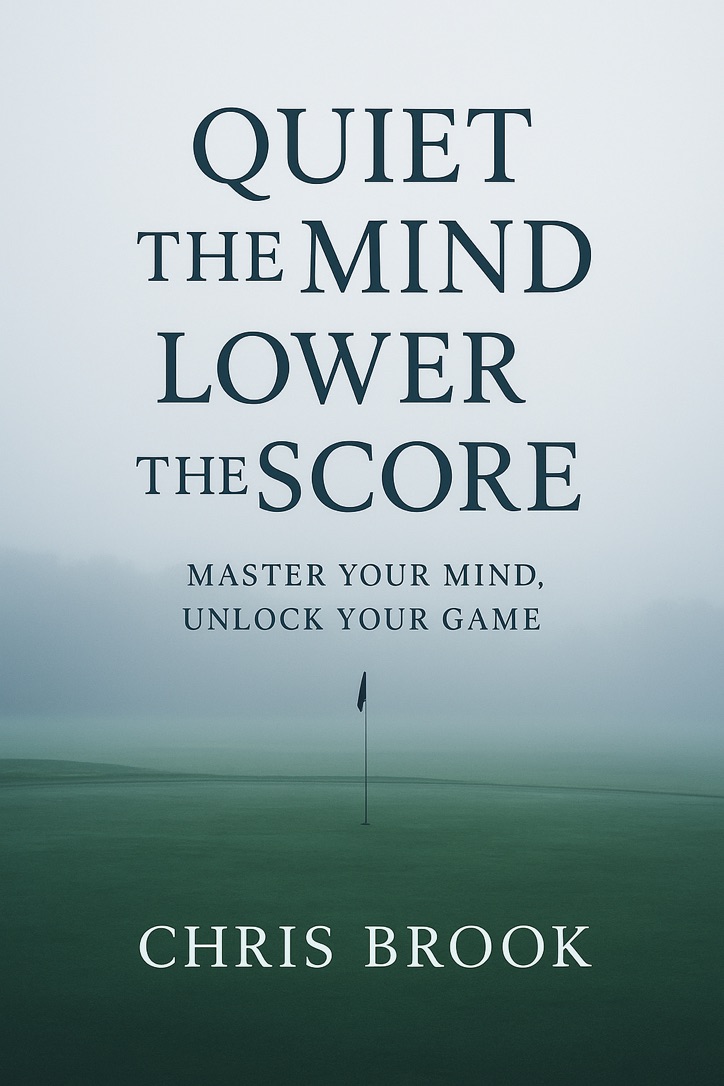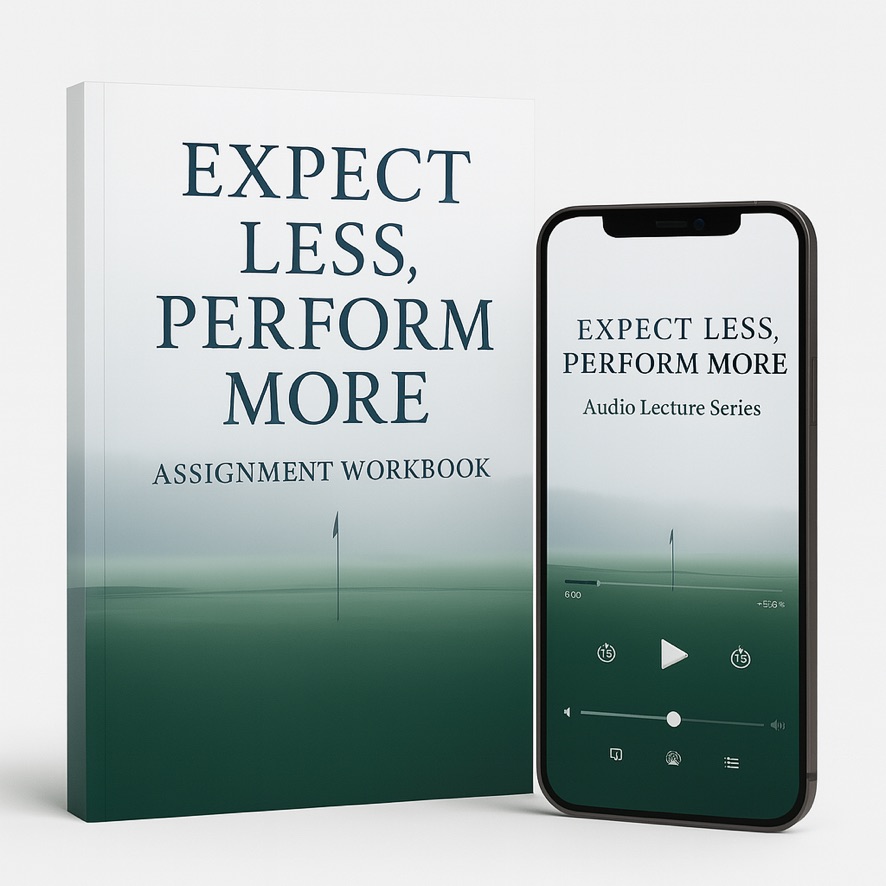The Chris Brook Clarity Method: Golf Coaching Built on Biomechanics, Psychology & Performance Identity
Clarity, not confusion. The Clarity Method integrates biomechanics, psychology, and performance identity into one process. It protects what already works, refines only what truly matters, and builds trust that holds up under pressure — without ever pulling your swing apart.
Why This Coaching Is Different
Many golfers worry that analysis means dismantling their swing or drowning them in technical detail. The Clarity Method does the opposite. It uses depth to simplify: to separate what only looks like a fault from what genuinely limits performance. Functional patterns are protected. Only meaningful barriers are refined. Golfers leave reassured, clear on what to keep, what to adjust, and why the change matters.
“Not every movement that looks wrong is the problem. A push to the right can be the body’s way of guarding against a feared left miss. My work is to uncover that truth and find the smallest change that unlocks the biggest gain.” — Chris Brook
About Chris
Chris Brook is a renowned Performance Psychology Specialist, Golf Biomechanist, TrackMan Master Professional, member of the PGA and published author whose work centres on one purpose: to help people quiet the noise within. His writing and teaching are rooted in clarity, not motivation, and in dismantling the internal distortions that keep players stuck in cycles of collapse, fear, and false performance.
His book, Quiet the Mind, Lower the Score, is the first in a forthcoming collection that guides readers to a deeper, transformational level, beyond technique and the mindset cliché, into the nervous system, identity, and perceptual truth underlying high-level performance. Rather than offering quick fixes or mental tips, Chris’s work challenges the very assumptions a player brings to the game. What results is not just better performance, but a more stable, grounded version of the person behind it.
With over 33 years of experience coaching internationally, leading top amateur players, tour professionals, and serious amateurs, Chris blends biomechanics, psychology, and identity reconstruction into a system that holds up under real pressure. His approach is serious, precise, and quietly confrontational, designed for those ready to let go of illusions and build something lasting.
Through Serion Publishing, his courses, and his private coaching work, Chris continues to write and teach for the player who’s no longer looking for confidence, but instead, looking for clarity.
He is based in the UK and works internationally.
Not a Butcher — A Builder of Clarity
Golfers often hesitate to seek coaching because they fear their swing will be torn apart. Chris built the Clarity Method so that never happens. The process protects functional patterns, clarifies the few true barriers to strike, flight, and confidence, and applies small refinements that carry the biggest return. The outcome is calm, not chaos — an approach that respects the golfer, guards their strengths, and turns analysis into trust.
Chris Brook's Clarity Method – The Three Pillars
The Clarity Method is built on three integrated pillars: Biomechanics, Psychology, and Performance Identity. Used together, they remove opinion and guesswork, simplify change, and reveal the smallest refinements that create the biggest gains — without tearing the swing apart.
Biomechanics
Biomechanics is not about chasing a Tour model. It is about understanding how the body moves and how the club is delivered, especially under pressure. Every movement expresses tendencies, restrictions, and even fears. Some apparent limitations are entirely functional when paired with a golfer’s natural sequencing and stability; some compensations are protective responses that keep the ball in play. Chris’s role is to read that story in 3D motion and ball-flight data, protect what belongs to the golfer, and refine only what genuinely disrupts strike, face control, or flight consistency.
Psychology
Most golfers can perform a new move in practice but lose it on the first tee because the brain resists the unfamiliar. Psychology is woven into every lesson so the mind supports change instead of fighting it. Chris explains why a refinement matters, exposes hidden fears that drive compensations, and links drills to trust rather than doubt. The result is a change that holds up when it matters most.
Performance Identity
Golfers play in line with who they believe themselves to be. If identity says “I crack under pressure,” the swing will tighten to match. Chris works at identity level so technical change lasts. From the pre-lesson questionnaire to the language used on the lesson tee, golfers move from fault-hunting to clarity-building, from fear-driven swings to a freer, more adaptable game. When identity shifts, performance follows.
Deep Analysis, Simple Refinements
Deep analysis is often misunderstood as a wall of numbers. In reality, it’s how Chris removes noise. A swing may appear to have several issues; look closely and you usually find one or two root causes. Address those and the rest resolve naturally. A push right, for example, is often a counter to a feared left miss. Treat the left trigger and the push fades without forcing a rebuild. Likewise, a cluster of balance and sequencing problems can reduce to a single restriction in hip mobility; create freedom there and strike, sequence, and control improve together. The purpose of going deep is not to complicate but to simplify.
“A surface view labels faults; detail reveals the one subtle change — in sequence, intent, or movement — that unlocks them all.”
How the Coaching Experience Works
The journey begins with a short questionnaire that focuses on perception rather than statistics: how a golfer sees their game, how they define consistency, and what progress means to them. Chris sits with those answers for a few days to shape an approach that fits the person, not a template. The first session builds rapport and explores language. Many golfers realise they value strike, trusted flight, or composure more than raw score; that self-realisation changes the path forward. Analysis is impartial, protective, and precise: functional patterns are kept, and only genuine barriers are refined. Technology clarifies patterns rather than dictating them.
What Golfers Say
“I was worried Chris would pull my swing to pieces. Instead, he showed me that most of what I did was functional — and that one small sequencing change freed my strike. I’ve never felt more confident.” — David, 67
“At my age I thought progress was over. Chris used biomechanics and psychology together to simplify, not complicate. My game feels mine again.” — Mary, 72
Quiet the Mind, Lower the Score — The Book
Quiet the Mind, Lower the Score captures the philosophy that underpins the Clarity Method: clarity over confusion, trust over fear, and lasting change over quick fixes. It explains why technical adjustments rarely hold on their own, why the brain resists change when pressure rises, and how clarity transforms performance. The studio brings those ideas to life.

Watch: How Clarity Beats Overload
This film opens the studio doors to show the difference between fault-hunting and clarity-based coaching. Chris explains why a movement that appears wrong can be a protective solution, and how deep analysis uncovers subtle refinements rather than overwhelm golfers with data.
Expect Less, Perform More — Digital Study Course
Expect Less, Perform More is Chris’s digital study programme for golfers who want to integrate mechanics, psychology, and performance identity at their own pace. Through audio modules and guided exercises, it shows how to reduce noise, clarify intention, and turn small refinements into performance that holds.

Technology as an Audit, Not a Crutch
3D motion capture, high-speed video, putting analysis, and ball-flight tracking are used to verify that improvements are real and on track. If work focuses on face-to-path control, the data confirms change by degrees rather than by feel. If putting sessions target roll and pace, the readings show that strike quality is translating into distance control. Over time, the audit keeps practice efficient and progress honest. Evidence replaces opinion; confidence replaces doubt.
Beyond the Swing
For most golfers the game isn’t just mechanics. It is identity, confidence, and a vital outlet beyond work and routine. Confusion corrodes all three. The Clarity Method restores clarity so golfers stand taller, swing freer, and enjoy the game again. The work improves ball flight and strike — and it reshapes how a golfer sees themselves when they walk onto the course. That shift is what makes improvement durable.
What to Expect from the Clarity Method
Expect protection rather than butchery, precision rather than overload, and support rather than isolation. You leave each session understanding exactly what to keep, the few refinements to apply, and the reasons those changes matter. Between lessons you are not left guessing: recordings and ongoing contact keep momentum. Most importantly, you come to trust your own game again — a swing that feels like yours, a mind that stays calm, and performance that stands up under pressure.